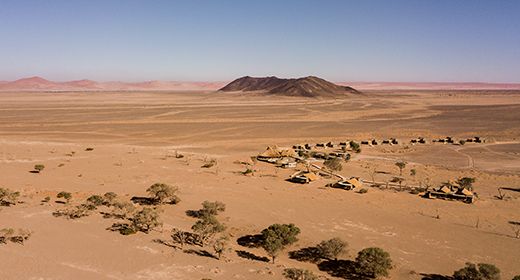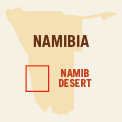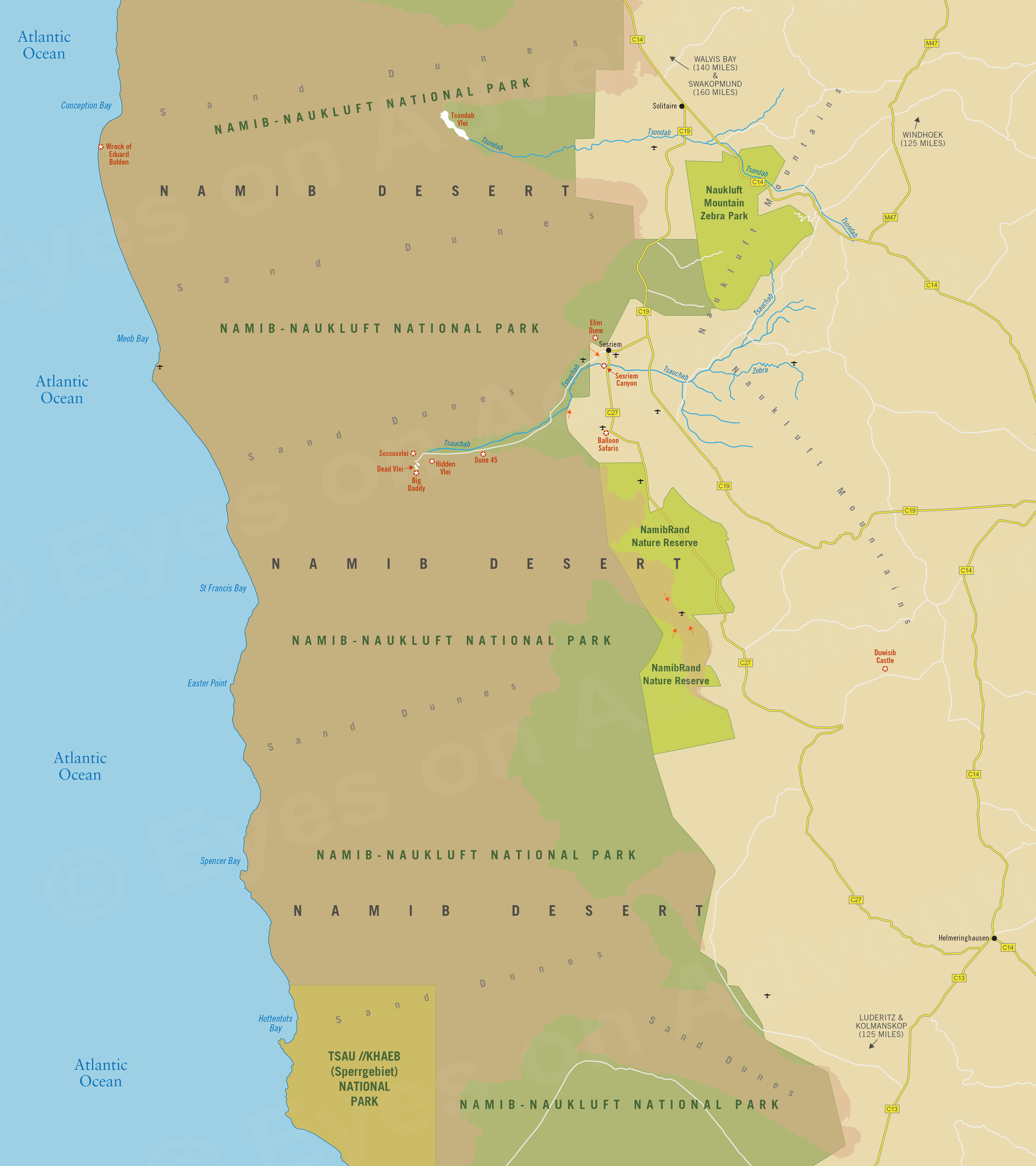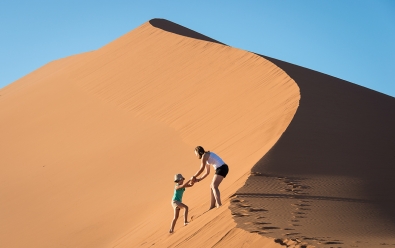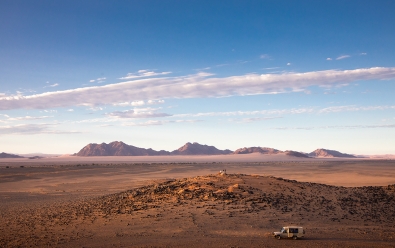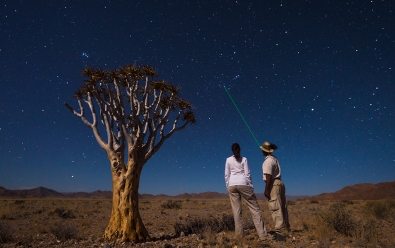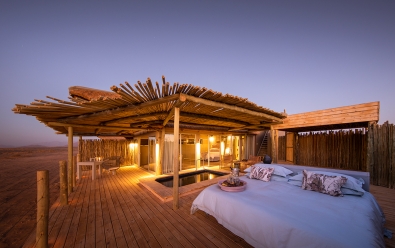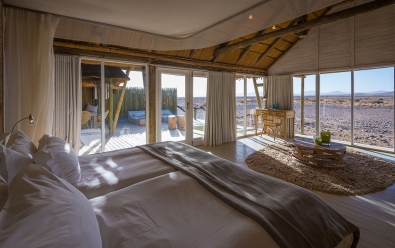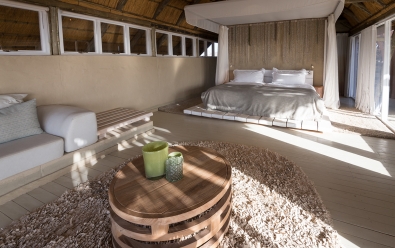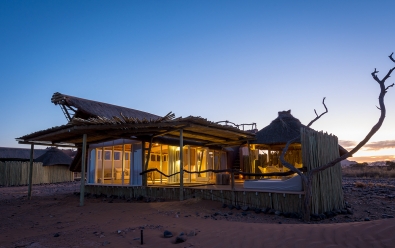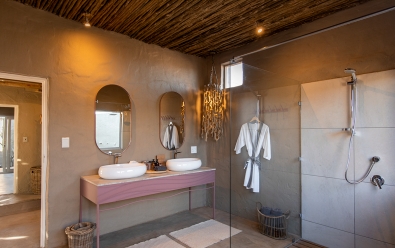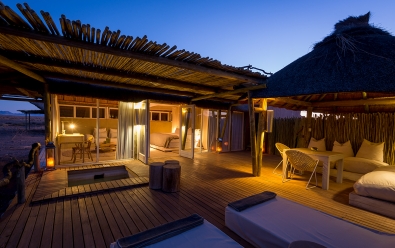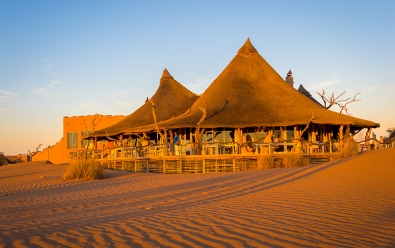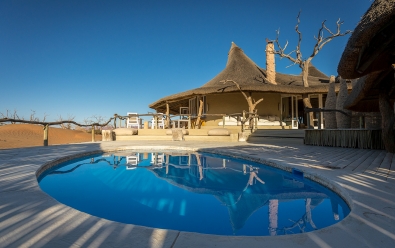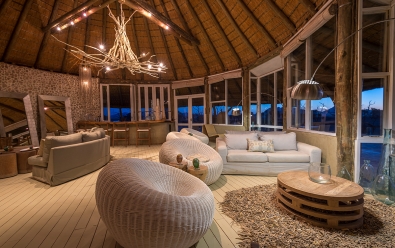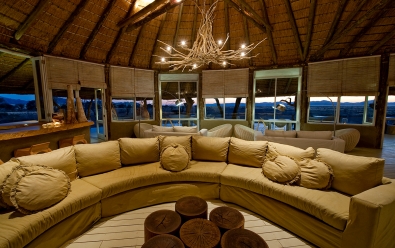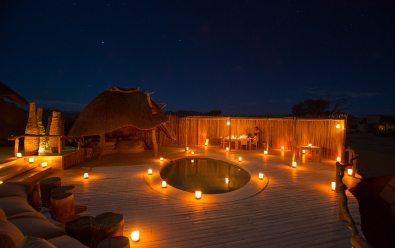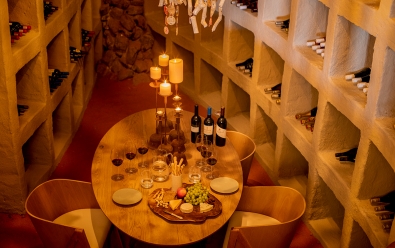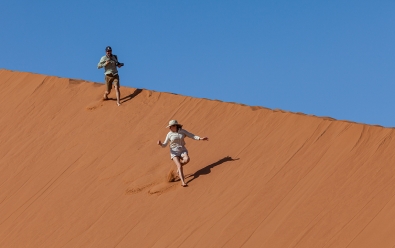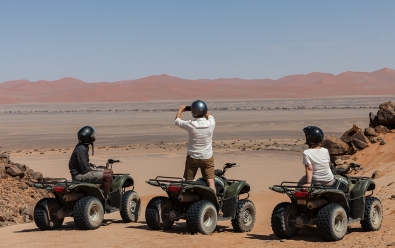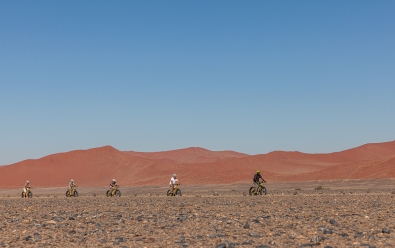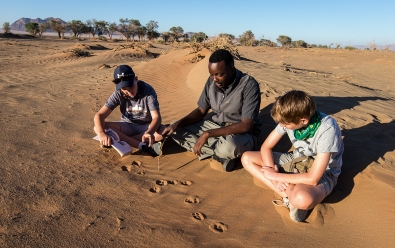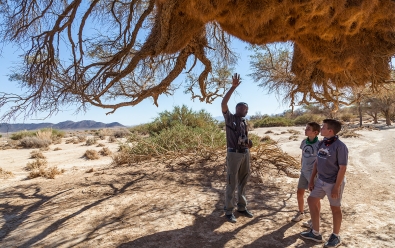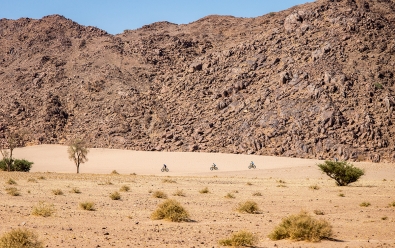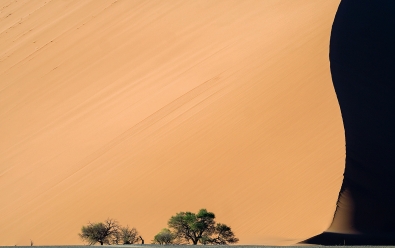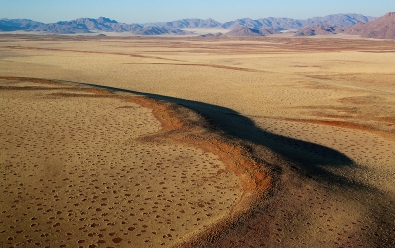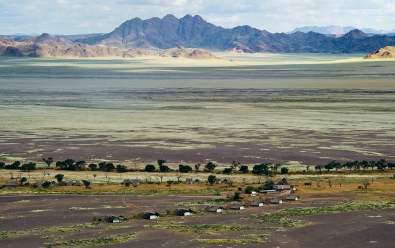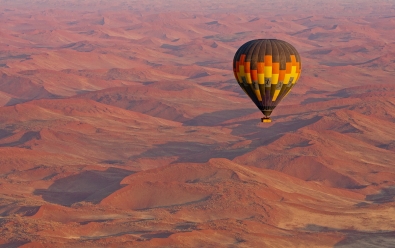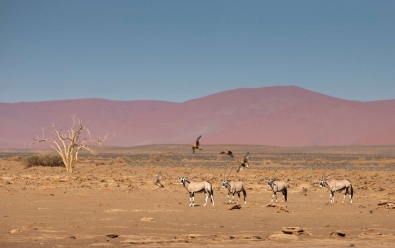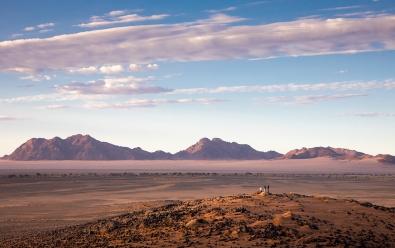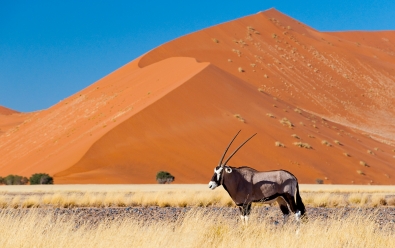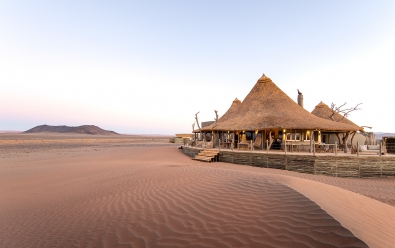Little Kulala Camp
Location
- Bordering Namib-Naukluft National Park
- Namib Desert
- Southwest Namibia
Little Kulala is located on a private reserve with exclusive access into the national park and its towering red sand dunes and other dramatic desert scenery.
Guests at the camp have exclusive access to the 104-square-mile (270-sq-km) Kulala Wilderness Reserve, which was created from land previously used for subsistence goat farming and is now a rehabilitated oasis for desert wildlife. The reserve borders Namib-Naukluft National Park and offers spectacular desert landscapes and some of the region's best wildlife viewing.
The private reserve has its own exclusive-use park gate, so guests avoid the long drive to the normal public-access gate used by the other camps in the area.
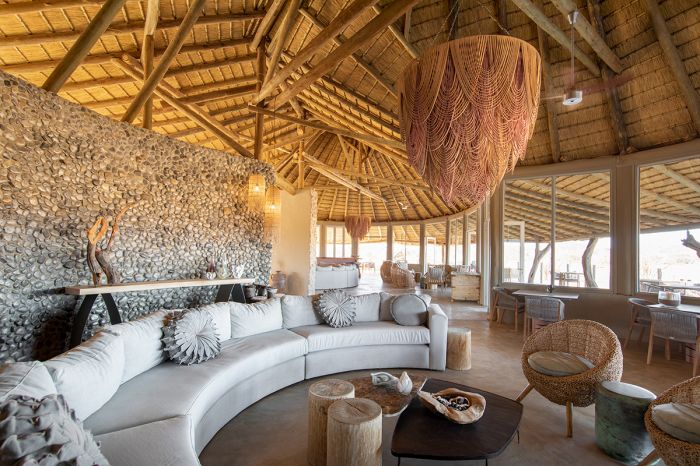
Main area living space at Little Kulala.
Wildlife seen around the camp includes springbok, oryx, bat-eared fox, Cape fox, aardwolf, porcupine, black-backed jackal, ostrich, spotted hyena, and sometimes brown hyena. The endemic dune lark is a bird that is restricted to the sand dunes of the Namib desert, where this species is often one of the few birds present.
Activities offered at Little Kulala include nature drives into the national park to explore the towering red sand dunes (including climbing 'Big Daddy' dune) and the incredibly photogenic Deadvlei, walking trails in the dry Tsauchab River bed, informative outings to learn about the geology of the region, drives to look for wildlife, quad-biking, and fat-tire pedal biking. Hot-air balloon rides are a great way to see the vastness of the 'sand dune sea'.
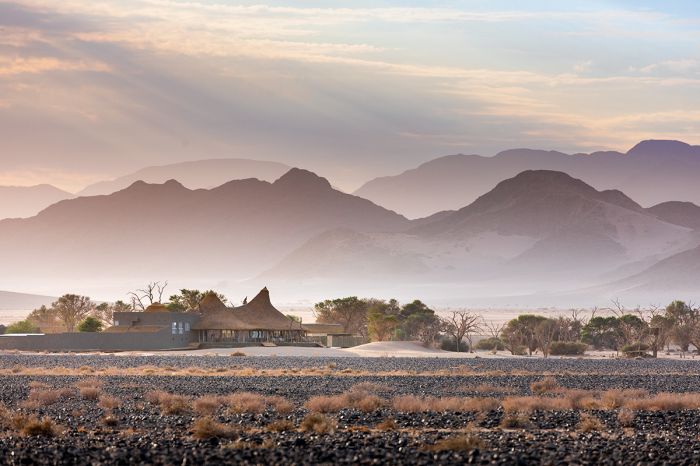
Little Kulala Camp and its spectacular desert scenery.
Little Kulala offers 11 spacious, climate-controlled guest suites, one of which is a double unit that is ideal for a family or couple looking for more space and luxury. The guests suites are built atop raised wooden decking and have private outdoor decks with a pool, and daybed/sala that can also be made up for a night of sleep under the stars. The suites also have a roof-top deck for private dining under the stars.
The camp's main area includes a spacious living space with lounge, dining, and bar areas and glass panels providing views of the beautiful scenery in all directions. The outdoor deck is often used for dining or just relaxing to enjoy the views. A flood-lit waterhole in front of the camp often attracts wildlife. There is also a pool and partially-shaded deck with loungers.
Wilderness Safaris are one of Africa's leading safari operators and they strive to minimize energy consumption at all their camps. Little Kulala Camp is 100% solar powered (solar panels and inverters provide electricity and hot water). A generator is used as a backup. Purified drinking water (through reverse osmosis) is supplied. Guest showers use solar-heated water. Strict eco-friendly environmental standards are maintained so that no harmful chemicals or waste is allowed to enter the ecosystem of this untouched wilderness.
In the ancient Namib Desert, rainfall is rare and never certain. In a typical year, the Sossusvlei area receives around 3.9 inches (100 mm) of rain or less. More often than not, rain storms leave as quickly as they arrive.
In January 2021, the area received unusually significant rainfall, with the onset of the year bringing an unexpected delight for all who were lucky enough to experience it. Guests and staff immersed themselves in the life-giving rains that brought a rare freshness to the normally dry desert land.
Watch the video below for a look at this special event.
About the Namib Desert
The Namib Desert is between 55-80 million years old and stretches along the western coast of Southern Africa from southern Angola, through all of Namibia and into northern South Africa, a distance of more than 1 200 miles (2 000 kms). The Namib is the only true desert in Southern Africa, averaging less than 1 inch of rain per year throughout most of its range.
The sand sea of wind-swept dunes along Namibia's coast spans a distance of 425 miles (680 kms) from Swakopmund in the north to Lüderitz in the south and inland for 90 miles (150 kms) in some places, including the Sossusvlei region.
Other than some scattered small settlements and the sparse population of semi-nomadic Himba and Herero people, the Namib is essentially uninhabited by humans. The dune-dominated areas of the Namib are also practically lifeless, with only some arthropods and other small organisms able to survive with almost no water.
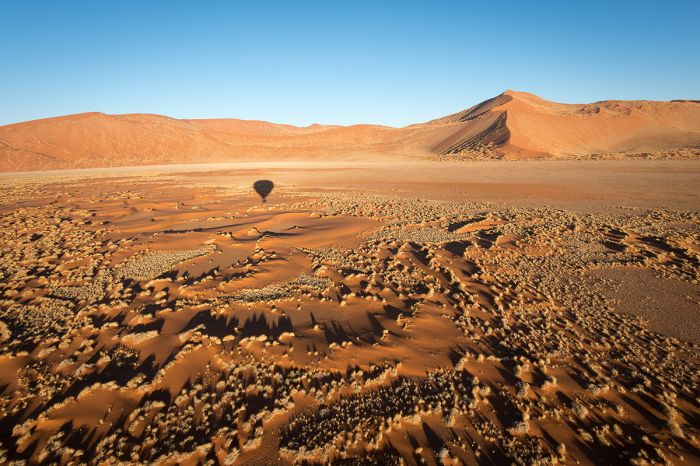
View of the Namib's 'sand sea' from a hot-air balloon ride.
Large animals are present in the areas not covered by the sand dunes, including antelopes like springbok and oryx. Other species present on the plains include desert-adapted elephant, Hartmann's mountain zebra, red hartebeest, ostrich, black-backed jackal, lion, brown hyena, meerkat, and some other species.
A large portion of the Namib Desert is protected as nature reserves and national parks, including Skeleton Coast National Park, Dorob National Park, and Namib-Naukluft National Park. Namib-Naukluft is the largest national park in Africa and one of the world's largest, covering an area of 19 215 sq miles (49 768 sq kms) and includes the popular Sossusvlei and Sesriem area, where many of the tourist lodges are located.
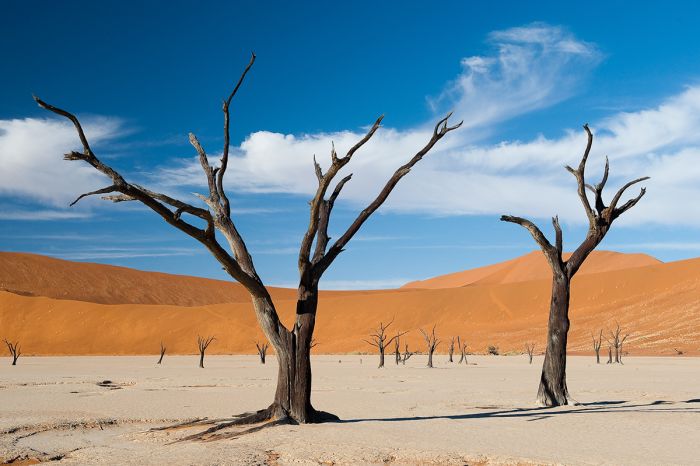
Dead camelthorn trees in Deadvlei.
About Sossusvlei
Technically, Sossusvlei (also written Sossusvlei Vlei) is one of many small, clay-encrusted pans that only fill with water in rare rain years and are otherwise bone-dry and surrounded by the reddish-orange sand dunes of the sand sea. The name "Sossusvlei" also refers to the rater large region that surrounds the Tsauchab River, the tiny town of Sesriem, all the towering sand dunes, including "Big Daddy" and "Dune 54", and all the pans, including "Dead Vlei".
The Sossusvlei area is characterized by massive sand dunes, open grassy plains, and ephemeral rivers that rarely flow. It is accepted that the massive sand sea of dunes here originated some 3-5 million years ago further south in present-day South Africa's Kalahari Desert. The sands were carried east by the Orange River and were dumped into the Atlantic Ocean, where they were carried north by the ice-cold Benguela Current offshore and deposited on Namibia's coast. Winds then blew the sand inland to form the huge sand sea.
The reddish color of the sand here is due to the high iron content and resulting oxidation. The redder the dune the older it is, whereas the younger dunes are more yellow in color. The dunes in the Sossusvlei region are spectacular to behold, some reaching height of over 1 000 feet (300+ meters) above the plains.
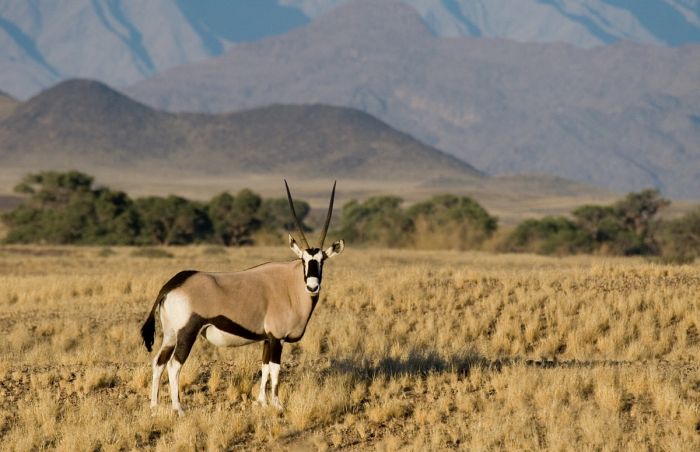
Oryx are one of the species that are well-adapted to living in the Namib Desert.
The very popular 'Big Daddy' dune at Deadvlei is about 1 066 ft (325 meters) high. Many of the oldest and tallest dunes around Sossusvlei are stabilized by some vegetation, which obtains moisture from the common morning fog that blows in from the Atlantic Ocean coast. Climbing Big Daddy or any of the other impressive dunes in Sossusvlei offers incredible 36--degree vistas from the top.
The Tsauchab River flows west from the Naukluft Mountains but only on occasion, with several years sometimes passing between flooding and even when it does flow, it rarely reaches all the way to the actual Sossusvlei Vlei pan.
Deadvlei, also located at the terminus of the Tsauchab River, is certainly the most popularly visited of the Sossusvlei pans owing to its amazing appearance with many long-standing skeletons of dead camelthorn trees.
The Tsauchab River used to flow into Deadvlei and eventually, a good number of camel thorn trees grew there, but at some point, the river's course changed and the pan stropped receiving any water, so the trees all died. The dead trees, white crusted pan, and surrounding red dunes makes for some absolutely incredible scenery, so don't miss it!
ROOMS INCLUDES & EXCLUDES CHILDREN FACILITIES ACTIVITIES
Accommodation
11 guest accommodations in total comprising:
- 10 twin-bedded, climate controlled suites (referred to as 'kulalas'), each with two three-quarter beds. Mattress converters are available that transform the twin beds into a king-size bed. To be arranged prior to arrival.
- 1 family unit consisting of two bedrooms, each with two three-quarter beds and each with its own en-suite facilities. Both bathrooms have an indoor shower, outdoor shower, double-basin vanity, and separate toilet. There are separate entrances via the shared outdoor deck, separate sleep out areas and a shared private pool.
Each suite is constructed using a combination of adobe earthen walls, wood, and glass atop raised wooden decking, offering views over the dramatic desert landscape. En-suite facilities include an indoor shower, outdoor shower, a double-basin vanity, and separate toilet.
Each unit also has a private outdoor deck with a plunge pool and comfortable seating. The outdoor decks also have a double-sala (bed) that can be made up on request and used for sleeping under the stars. The units also have rooftop decks that can be used for starlit private dinners or stargazing.
The units are connected to the main camp area by a slightly elevated wooden walkway.
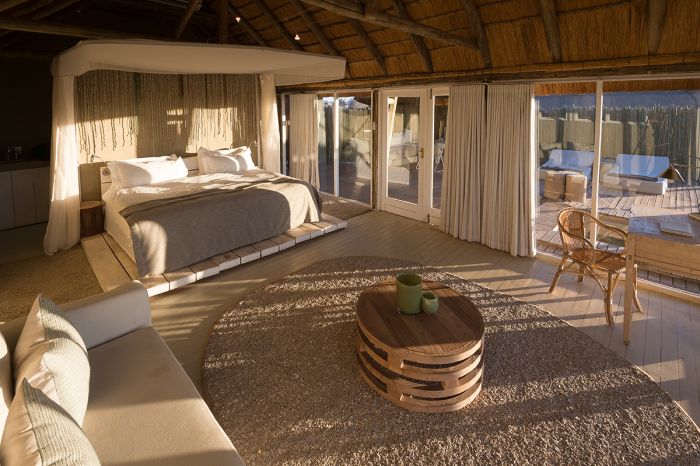
Guest suite interior with view to the outdoor pool deck.
The guest units are spacious and climate-controlled (via an air-conditioning unit), with the adobe walls to help keep them cool during the day and comfortable at night. The design and décor of the suites blend well with the natural desert surroundings. Amenities include a writing desk and chair, a lounge area with a chaise and easy chair, multi-plug charging facilities, a private outdoor shaded veranda and pool deck with chairs, daybed/sala, a stargazing rooftop deck, and mosquito netting for the beds.
Other items and features in the guest units include:
- Electronic safe.
- Luggage rack.
- Mini-bar.
- Air conditioning unit.
- During winter months, hot water bottles and extra blankets are provided.
- Tea and coffee making facilities.
- Yoga mat and free weights.
- In-tent Wi-Fi.
- Personal amenities, including bathrobes, slippers, liquid soap, body wash, shampoo and conditioner, body lotion, room spray, insect repellent, tissue dispenser, shower caps, cotton-tip swabs, cotton balls, laundry bag, umbrella, and garment washing powder (for underwear).
Little Kulala Camp can accommodate a maximum of 24 guests in total: 2 adults and 2 children in the family unit and 2 persons in each of the other 10 standard guest units.
Includes & Excludes
Includes:
- All meals and local beverages including wines, spirits and liqueurs, but excluding premium imported brands and Champagne.
- Twice-daily scheduled camp activities (accompanied by experienced guides).
- Laundry services are provided on a daily basis (weather permitting, items will be returned on the same day). Laundry is dried by the sun and on most days any laundry placed out in the morning will be returned by the evening. Note that laundry services may be limited as a result of water shortages.
- Wi-Fi access.
- Tourism levy and VAT.
Excludes:
- Premium imported beverages and Champagne.
- Any applicable wildlife fee, park fee, reserve fee, concession fee, other land-use fee.
Single Supplement
A single supplement will apply for any room booked by a single traveler; please ask us for pricing.
Children
Children aged 6 years and older are accommodated at Little Kulala Camp:
- For families traveling with children between 6 and 12 years, private activities must be booked and paid for.
- Children between 6 and 16 years must share with an adult/s in the same room.
- The minimum age for walking activities is 13 years.
- No age limitation for hot-air ballooning.
Facilities
The camp's clean design and interiors reflect the stark but beautiful desert surroundings in the region.
Main area facilities include:
- Pool in main area with partially shaded deck and loungers.
- Thatched-roofed main area comprises a reception area, a lounge/dining area, and a bar area, all on a raised wooden deck.
- Open outdoor deck overlooking the camp's floodlit waterhole.
- Campfire area.
- Safari Trading Store.
- Library.
- Upstairs lounge area with photo download centre (Photo Hub).
- A pair of Olympus binoculars in the main area.
- Open fireplaces.
- During winter months, a gas heater is stationed in the main area, with blankets and hot water bottles provided during dinner.
- Spa.
Activities
Activities included in the rate:
- Day and night nature drives in 4x 6-seater closed Land Cruisers and 2x 8-seater Land Cruisers with pop-up roof. During winter months, hot water bottles (on early morning game drives only), blankets, and lined ponchos are provided.
- Birding.
- Excursions to Sossus Vlei and Sesriem. Only the two Wilderness Safaris camps (Kulala Desert Lodge and Little Kulala) have the advantage of entry into the national park through this exclusive gate entrance. Self-drivers or freelance guides driving non-Wilderness camp vehicles are not permitted to use this private gate and will be re-routed by Park Officials to the general public access gate at Sesriem.
- Scenic sundowner excursion.
- Tsauchab River trails (in the dry riverbed) revealing the “living desert” (activities focused on geology, astronomy, and the rehabilitation of the reserve with out-of-camp experiences ranging from fairy-circle dinners to river oasis lunches).
- Self-guided walking trails.
- Guided night-time scorpion walks (weather permitting).
- Cultural campfire evenings.
- Wine tastings in the wine cellar.
- Pre-dinner and fireside discussions by camp staff covering the area’s geology and rehabilitation process from its previous subsistence goat farms back to its current natural environment.
- Stargazing with a laser pointer (weather permitting and according to the lunar phases (not offered around full moon).
- Quad biking.
- Fat-tire pedal biking.
Optional activities at additional cost:
- Private activities are on offer (subject to vehicle availability which needs to be booked in advance).
- Booking of a private vehicle from Kulala Desert Lodge is not possible.
- Hot-air balloon rides (at extra cost).
Example of a typical day:
- Early morning wake-up call.
- Light breakfast before departing on the morning activity.
- Return to camp for a meal and rest period. Note that full-day trips can be arranged in camp.
- Meet for afternoon tea and snacks (savory and sweet choices) before departing on the activity.
- Return to camp - freshen up or meet for drinks, followed by dinner.
- Enjoy a nightcap and/or discussion around the campfire before retiring.
Great Good Fair Poor
- Jan
- Feb
- Mar
- Apr
- May
- Jun
- Jul
- Aug
- Sep
- Oct
- Nov
- Dec
Climate / When to Visit
The Central Namib-Naukluft, including the Sossusvlei region, have a hot and dry, true desert climate with little to no rainfall throughout the year (less than 1 inch on average annually). As is common in a desert, daytime temperatures can be very warm, averaging 82-85°F (28-29°C), but often spiking above 100°F (38°C) during the summer. Conversely, overnight lows in the winter can fall below freezing.
Morning fog blows in from the coast over the sand dunes about one out of every two days. The thick for is created when cold coastal water brought north via the Benguela Current mixes with the the hot, dry air of the desert. The coastal fog has led to hundreds of shipwrecks along the coast, but it provides a vital source of moisture for desert plants and animals living inland. The fog typically burns off mid mid-morning.
Sossusvlei can definitely be considered a year-round destination, with winter months being better if you are concerned about the heat, but keep in mind that most activities take place starting very early in the morning and again late in the afternoon, so as to avoid midday heat.
Little Kulala is open year-round.
Summer
The summer months are November through April and middays in the desert can only be describer as hot. Early morning are white pleasant, with temperatures around 60°F (15°C), but quickly warming to around 85°F (29°C) once the sun moves overhead. Almost every day is clear and sunny, with some clouds blowing through.
Summer is the 'rain' season, although that is not to say that one should expect any showers. January and February are the best chances to experience rain in the region (a truly special treat if you happen to get this lucky). Rains are rare and typically come as a brief shower that quickly moves off. Heavier, lasting rains are very uncommon, usually only coming every few years.
Winter
The winter is from May through October and the daytime temperatures are moderated compared to the summer and overnights can be quite chilly to cold (as is typical of a desert climate).
Temperatures during the day average 73-75°F (23-24°C), but often climb to 80°F (27°C). Early mornings are brisk, averaging 48-50°F (9-10°C), while nighttime temperatures regularly drop to near freezing or even lower.
Rain during the winter months is extremely rare and most days are completely cloudless and sunny.




